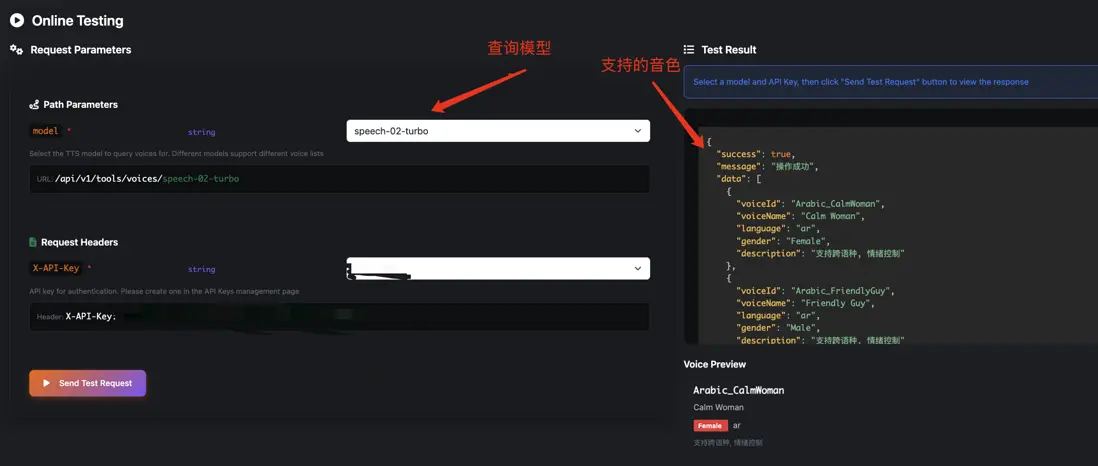在一些需要高質量文本轉語音(TTS)的場景中(比如:有聲書配音、播客等)。之前介紹的EdgeTTS方案可能效果沒有那麼好。此時就比較推薦使用 MiniMax、CosyVoice這些提供的音色,這些音色的效果會更加擬人、逼真,接近真人發音。這裏依然通過 UnifiedTTS 的統一接口來對接,這樣我們可以在不更換客户端代碼的前提下,快速在 MiniMax、CosyVoice等引擎之間做無縫切換。本文將引導讀者從零到一把MiniMax、CosyVoice的語音合成能力整合到你的Spring Boot應用中,最後也會給出一個可複製的 Spring Boot 集成示例,
實戰
1. 構建 Spring Boot 應用
通過 start.spring.io 或其他構建基礎的Spring Boot工程,根據你構建應用的需要增加一些依賴,比如最後用接口提供服務的話,可以加入web模塊、lombok等常用依賴:
<dependencies>
<dependency>
<groupId>org.springframework.boot</groupId>
<artifactId>spring-boot-starter-web</artifactId>
</dependency>
<dependency>
<groupId>org.projectlombok</groupId>
<artifactId>lombok</artifactId>
</dependency>
</dependencies>2. 註冊 UnifiedTTS,獲取 API Key
- 前往 UnifiedTTS 註冊並獲取 API Key
- 記錄下創建的ApiKey,後續程序配置的時候需要使用
3. 集成 UnifiedTTS API(使用 MiniMax、CosyVoice)
下面給出參考實現,包括配置、DTO、服務與控制器。與 EdgeTTS 版本相比,主要是將 model 與 voice 改為 MiniMax/CosyVoice 支持的參數。
3.1 配置文件(application.properties)
unified-tts.host=https://unifiedtts.com
unified-tts.api-key=${UNIFIEDTTS_API_KEY}這裏 unified-tts.api-key 請替換為你在 UnifiedTTS 控制枱創建的 API Key。
3.2 配置加載類與請求/響應封裝
// src/main/java/com/example/tts/config/UnifiedTtsProperties.java
@Data
@ConfigurationProperties(prefix = "unified-tts")
public class UnifiedTtsProperties {
private String host;
private String apiKey;
}
// src/main/java/com/example/tts/dto/UnifiedTtsRequest.java
@Data
@AllArgsConstructor
@NoArgsConstructor
public class UnifiedTtsRequest {
private String model; // 例:minimax-tts 或 cosyvoice-tts
private String voice; // 例:zh_female_1(按模型支持的音色選擇)
private String text;
private Double speed; // 語速(可選)
private Double pitch; // 音高(可選)
private Double volume; // 音量(可選)
private String format; // mp3/wav/ogg
}
// src/main/java/com/example/tts/dto/UnifiedTtsResponse.java
@Data
@AllArgsConstructor
@NoArgsConstructor
public class UnifiedTtsResponse {
private boolean success;
private String message;
private long timestamp;
private UnifiedTtsResponseData data;
@Data
@AllArgsConstructor
@NoArgsConstructor
public static class UnifiedTtsResponseData {
@JsonProperty("request_id")
private String requestId;
@JsonProperty("audio_url")
private String audioUrl;
@JsonProperty("file_size")
private long fileSize;
}
}3.3 服務實現(RestClient 同步合成)
// src/main/java/com/example/tts/service/UnifiedTtsService.java
package com.example.tts.service;
import com.example.tts.dto.UnifiedTtsRequest;
import com.example.tts.config.UnifiedTtsProperties;
import org.springframework.http.MediaType;
import org.springframework.http.ResponseEntity;
import org.springframework.stereotype.Service;
import org.springframework.web.client.RestClient;
import java.io.IOException;
import java.nio.file.Files;
import java.nio.file.Path;
@Service
public class UnifiedTtsService {
private final RestClient restClient;
private final UnifiedTtsProperties properties;
public UnifiedTtsService(UnifiedTtsProperties properties) {
this.properties = properties;
this.restClient = RestClient.builder()
.baseUrl(properties.getHost())
.build();
}
public byte[] synthesize(UnifiedTtsRequest request) {
ResponseEntity<byte[]> response = restClient
.post()
.uri("/api/v1/common/tts-sync")
.contentType(MediaType.APPLICATION_JSON)
.accept(MediaType.APPLICATION_OCTET_STREAM, MediaType.valueOf("audio/mpeg"), MediaType.valueOf("audio/mp3"))
.header("X-API-Key", properties.getApiKey())
.body(request)
.retrieve()
.toEntity(byte[].class);
if (response.getStatusCode().is2xxSuccessful() && response.getBody() != null) {
return response.getBody();
}
throw new IllegalStateException("UnifiedTTS synthesize failed: " + response.getStatusCode());
}
public Path synthesizeToFile(UnifiedTtsRequest request, Path outputPath) {
byte[] data = synthesize(request);
try {
if (outputPath.getParent() != null) {
Files.createDirectories(outputPath.getParent());
}
Files.write(outputPath, data);
return outputPath;
} catch (IOException e) {
throw new RuntimeException("Failed to write TTS output to file: " + outputPath, e);
}
}
}3.4 單元測試(MiniMax/CosyVoice)
// src/test/java/com/example/tts/UnifiedTtsServiceTest.java
@SpringBootTest
class UnifiedTtsServiceTest {
@Autowired
private UnifiedTtsService unifiedTtsService;
@Test
void testSynthesizeToFileWithMiniMax() throws Exception {
UnifiedTtsRequest req = new UnifiedTtsRequest(
"speech-02-turbo",
"Chinese (Mandarin)_Gentle_Youth",
"你好,歡迎使用 UnifiedTTS 的 MiniMax 模型配音。",
1.0,
0.0,
1.0,
"mp3"
);
Path projectDir = Paths.get(System.getProperty("user.dir"));
Path resultDir = projectDir.resolve("test-result");
Files.createDirectories(resultDir);
Path out = resultDir.resolve(System.currentTimeMillis() + ".mp3");
Path written = unifiedTtsService.synthesizeToFile(req, out);
assertTrue(Files.exists(written), "Output file should exist");
assertTrue(Files.size(written) > 0, "Output file size should be > 0");
}
}4. 運行與驗證
執行單元測試之後,可以在工程目錄 test-result 下找到生成的音頻文件:
如果你希望拿到音頻 URL 或 Base64,可將接口 accept 改為 application/json 並解析返回結果,再做下載或解碼。
5. 常用參數與音色選擇
model:speech-02-turbo(示例),不同規格以官方為準;voice:示例Chinese (Mandarin)_Gentle_Youth等;rate:語速(建議範圍 0.8–1.2);pitch:音高(建議範圍 -3–+3);volume:音量(建議範圍 0.8–1.2);format:mp3(常用)、wav(無損但體積大)、ogg等。
模型model與音色voice 這裏推薦使用 minimax 或 cosyvoice的模型和音色。
具體支持的參數可以在API文檔中的接口查詢可以填入的參數,比如:
model支持,調用一下可以看到,支持的模型有:
每個模型下支持的voice,也可以調用接口查詢,比如這裏嘗試調用minimax支持的voice:
6. 異常處理與重試建議
- 超時與網絡錯誤:設置
timeout-ms,在onErrorResume中記錄原因; - 4xx/5xx:區分鑑權失敗、限流、服務器錯誤並上報;
- 重試策略:對臨時性錯誤採用指數退避(帶抖動);
- 併發與限流:高併發場景實現隊列或令牌桶;
- 緩存:對重複合成按
text+voice+params做緩存,降低成本與時延。
7. 生產化建議
- 安全:API Key 從環境變量或密鑰管理系統注入;
- 監控:記錄合成耗時、失敗原因、重試比率;
- 存儲:落盤或對象存儲(如 S3)並設置生命週期;
- 規範:統一 DTO 與服務返回結構,便於多模型擴展;
- 擴展:通過配置切換 Azure/Edge/Elevenlabs/MiniMax 等模型。
小結
通過 UnifiedTTS,我們在 Spring Boot 中僅需調整 model 與 voice 即可切換到 MiniMax、CosyVoice、甚至最強的Elevenlabs,實現文本轉語音。統一接口簡化了多引擎維護成本,讓你能在成本、音色與效果間自由選擇。根據業務需求,還可進一步完善異常處理、緩存與併發控制,構建更可靠的生產級 TTS 服務。
另外,對比了官方API和UnifiedTTS的價格,後者更具備價格優勢,所以非常推薦獨立開發者或者初創產品的時候使用。不論從開發成本還是API成本角度看都是最佳選擇。


























